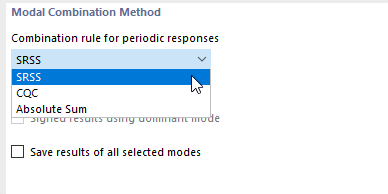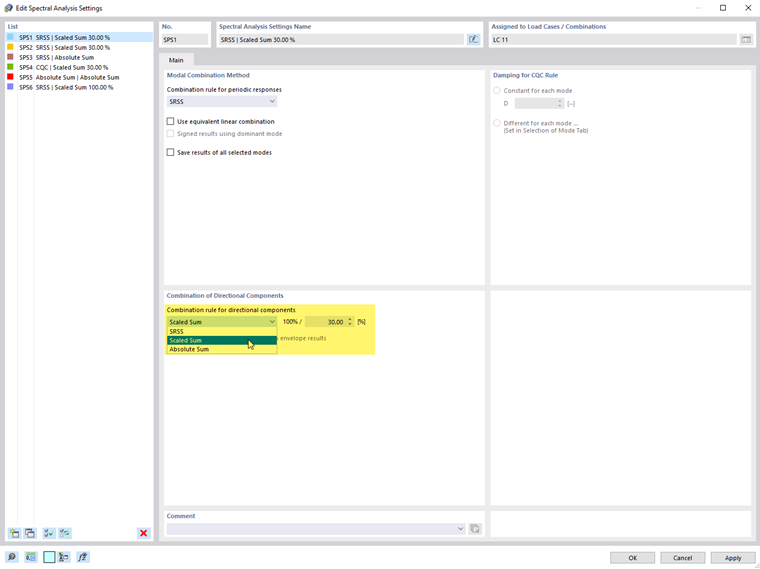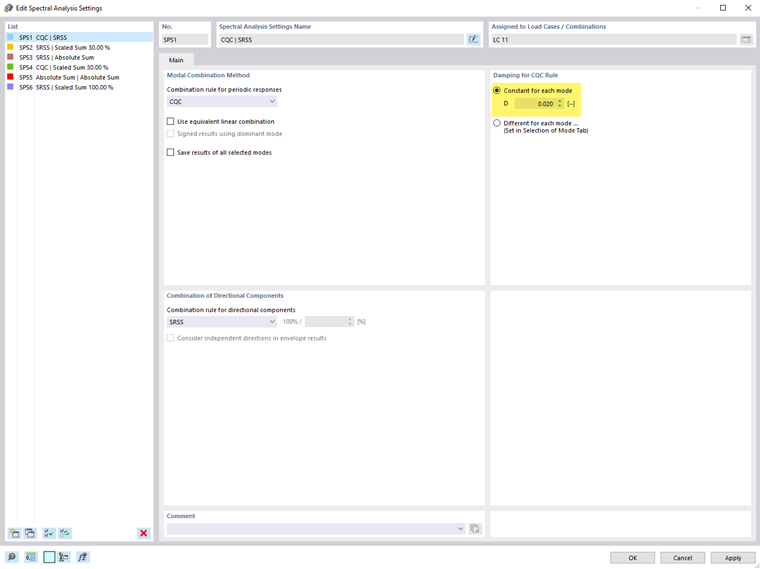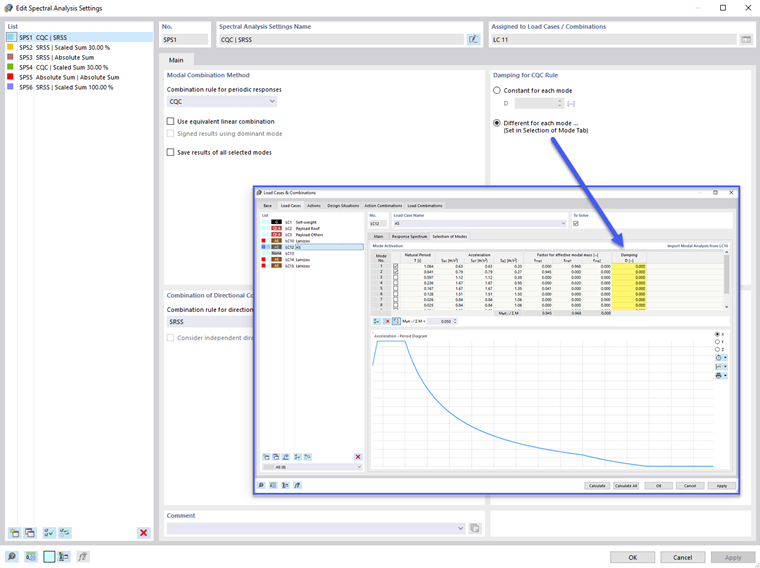A spectral analysis setting (SLS) specifies the rules according to which the resulting forces and deformations are calculated. A standard analysis type is preset. You can adjust this type or create further spectral analysis settings at any time.
The "Spectral Analysis Settings" dialog box controls the settings of the analysis type selected in the "List" on the left.
Modal Combination Method
In this section, you can specify the method by which the results of the modal analysis are superimposed, as well as which results are prepared for output.
Combination Rule for Periodic Responses
The list provides three options for combining the results from various mode shapes of the model. The modal results of a response spectrum analysis are usually superimposed quadratically. This superposition is the first step of the dynamic combination.
- SRSS – Square Root of Sum of Squares
The standard form of the SRSS rule combines the maximum results quadratically. The algebraic signs are lost in the process. The combination rule is as follows:
The combined results ESRSS result from the modal responses Ep from p mode shapes of the model.
The SRSS rule is only allowed for models where the neighboring natural frequencies Ti < Tj deviate by more than 10%. Therefore, the following condition must be met:
If this is not the case, the CQC rule must be applied.
- CQC – Complete Quadratic Combination
The CQC rule is defined as follows:
Using the correlation coefficient εij, the damping and the angular frequencies are determined:
|
Di, Dj |
Damping values |
|
r |
Quotient of the natural angular frequencies (ωj/ωi) |
You can enter the damping values Di in the Selection of Modes tab of the "Load Cases and Combinations" dialog box in the Damping column (see also the image Specifying Damping for CQC Rule).
If the viscous damping value D is the same for all mode shapes, the correlation coefficient ε is simplified as follows:
|
D |
Dämpfungswert |
|
r |
Quotient der Eigenkreisfrequenzen (ωj/ ωi) |
In this case, enter the damping value D directly in the Damping for CQC Rule section of the dialog box.
- Absolute Sum
It is also possible to superimpose modal combinations conservatively by using the absolute sum. The absolute sum is obtained as follows:
Using Equivalent Linear Combination
In the case of the quadratic combination according to the SRSS or CQC rule, the direction of the excitation and thus the sign of the result are lost. Therefore, the results are always given as maximum values in the positive as well as in the negative direction. Corresponding internal forces, such as a corresponding moment at the maximum axial force, are lost. This can be avoided by modifying the SRSS and CQC rule: The formulas are not written as a root, but as a linear combination. This rule was introduced by Katz [4].
The equivalent linear combination for the superposition according to the SRSS rule is as follows:
The equivalent linear combination for the superposition according to the CQC rule is as follows:
Detailed information about the superposition of modal responses in the response spectrum analysis using the equivalent linear combination can be found in Knowledge Base 001823.
Signed Results Using Dominant Mode
The function is still under development and therefore not accessible.
Combination of Directional Components
In this section, you can specify how to combine the results from different excitation directions. The combination of directional components is the second step of dynamic combinations.
- SRSS (Square)
The internal forces from different excitation directions can be combined quadratically according to the SRSS rule. It is applied with i = 1 ... p for the excitation directions X, Y, and Z. The SRSS rule for the combination of directions can also be performed as an equivalent linear combination.
- Scaled Sum (100%/30% or 100%/40%)
The combination of the directional components can also be performed as a user-defined scaled sum, as specified in EN 1998‑1 [5] 4.3.3.5.1(3), for example. Define the percentage value in the text box. With the 100%/30% rule, the combination is as follows:
- Absolute Sum
You can also combine the directional components conservatively with the absolute values. The absolute sum is obtained as follows:
Considering Independent Directions in Envelope Results
The function is still under development and therefore not accessible.
Damping for CQC Rule
This dialog section is available if you have specified a CQC rule for the superposition of the modal analysis results.
The Lehr's damping values Di are required for the CQC rule. They can be specified as equal (constant) or defined differently for each mode shape of the model.
Constant for Each Mode
If the damping is the same for all mode shapes, you can specify the damping value D here.
Different for Each Mode
You can enter the damping values Di required for the calculation of the correlation coefficient εij in the Selection of Modes tab of the "Load Cases & Combinations" dialog box in the Damping column.




